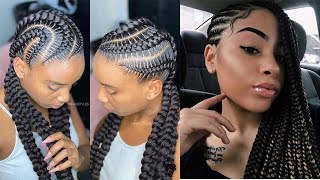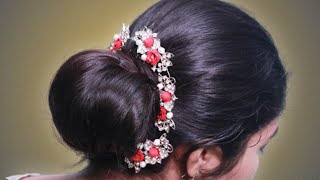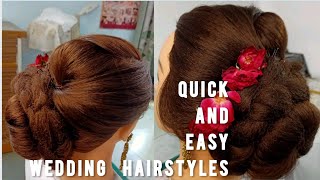Interlocking/Net Weave Part 3
- Posted on 17 May, 2012
- Sew-In Hair Extensions
- By Anonymous
This interlocking/net weave technique can also be used for covering areas of severe hair loss. The flat attachment allows the net to lay flat on the head to achieve the most natural look.
This manikin represents a client with severe hair loss. The interlocking technique will be used to create a flat track around the perimeter, starting with a 1 inch parting. The hair is laid down making a knot to secure that section, making sure to knot it two or three times to secure it. Another one-inch party is attached securely to the previous section. This technique is done, one section at a time. The knot must be secured two or three times the secured hair is locked over to the right with moderate tension to tighten the section loop, stitch or locking stitch is used to reinforce the one inch section loop stitch, also known as locking stitch, is a reinforcement stitch That will have a stronger hold than any stitch. The excess hair is dropped after sewing the one-inch section. Another one-inch parting is made. It is attached and securely knotted, at least two times to the previous completed section. The knotted hair is locked over to the right with moderate tension to create another one-inch section. The section is then looped stitched, locking each section is important as this secures and reinforces each section. This procedure is done one inch at a time. Small partings must be taken to ensure a flat application. This can be done on any section of the head. It can also be used instead of braiding, especially in a case where the hair is very short. At this point, our client has a missing gap in the air. One of the most exciting features of this technique is that bridges can be created to fill in gaps where the hair is missing. Hair is taken from the right and stretched over to the left. It is knotted securely. The excess hair is now locked over to the right to form a bridge. The section is thin loop stitched securely. The wefted hair is measured to fit the section. The web good hair is attached to the flat track using the same loop stitch. Making sure that the wefted hair lays flat and secure is the thread is about to get short. A knot is made by looping the thread and a knot several times in the same spot. This will reinforce the section the needle is then inserted through the base and the web several times until the thread gets shorter and shorter. The thread is, then, cut leaving an excess of about one inch. The purpose of this is to include it in the next section. So that it will not be exposed and become unraveled, we will demonstrate a unique way to start sewing without having to knot. The thread begin in the same spot by pulling the thread through the base, leaving about two inches of thread free at the end looping and pulling gently on the first stitch loop again in the same spot, pulling a little tighter this time loop again and pull even Tighter to secure the knot, this is the preferred method, as handmade knots become loose easily after constant shampooing, the weft is stitched, making a complete circle. The weft is knotted to reinforce it. The excess hair is cut off in preparation to attach the net, which will be demonstrated in the next segment. The red marking on the scalp was placed as a guideline for the closure. It was placed in an off-center position to achieve a more natural look.





Comments
BerryQueenNewWave: Thank you for sharing this technique. Alopecia is a real problem for many women and young girls. This is a great way to help them feel better about themselves.
Alex jones: Hello, i have a question how do you take the interlock weave out without damaging the hair?
Donjanelles Enterprise LLC: Yes it can be braided under the net. The part 2 net video shows it but is also done on healthy hair
LivingLifeVividly: Is the removal process difficult? I would be afraid that I would accidentally cut the actually hair when trying to remove the wefts.
Shaquita Combs: does this cause a lot of damage to the hair?
Aries K: how do you remove without damaging hair
o mago do alongamento Weder Montemor: Demais
blaqonblaq: where is the last part in attaching the netting?
Annie Small: This looks like a great technique for women with alopecia
cassie wilson: Where's the next video to show how to place and sew the net? Over the bald spot.I would love to see it and how to do the closure.
Gloria Young: Where is the interlocking for the net part 3
804Braids&More: ITS OK. YOUR RIGHT ;)
Tina F: Where is the last video showing how to do the net? And how does that work if you have hair but want to cover it with the net....do you braid it down?
WaffleFace23 23: ..on their actual hair. Its 2013 and cosmetology has advanced in a huge way to where we are now discovering ways to protect our natural hair and promote growth with extension techniques and a stable hair regimen. Please go read a book before attempt to slander your own race on the internet.
SABINA'S TIME: This looks dangerous. It is like a disaster awaiting to happen to any client.
PositiveNature: Also there's no way a woman with nails like that should be touching your hair. Who knows what types of bacteria she's harbouring under those nails.
Rozella Trabue: How to cut hair How to cut hair
Adhami Sarido: Ok yes
PositiveNature: This is my business, because I am black. Do you think it's cool for black women to have receeding hairlines, forever using weaves and steriod injections to stimulate hairgrowth, when they can just not damage their hair in the first place? Do you think it's cute for 16 year old black girls to have no hair and harbour jealousy towards other black chicks who have healthy hair? Why are you condoning destructive behaviour?On the other hand, I don't really care what white girls do to their hair.